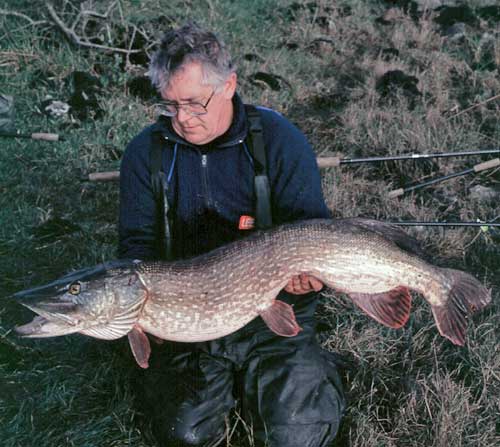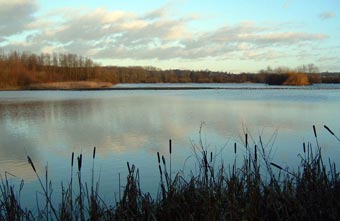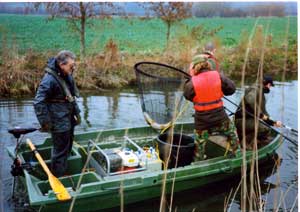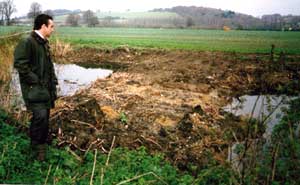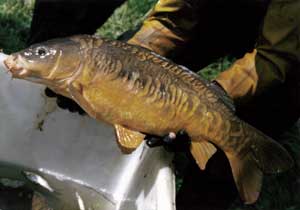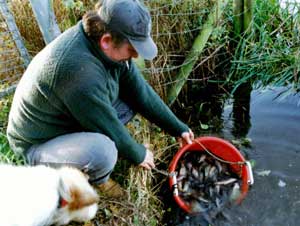Opinion Piece – Pike and the Managed FisheryProblem or Prima Donna?What has sparked off this piece is the fairly recent news of the culling of some pike from a trout stream. I suppose what got up anglers’ noses more than anything was the fact that the cull was carried out by students and the fish were later stuffed, we believe. What came out from the complaints (rants, more like) was all the old comments such as “… pike are good for a fishery ….. leave the pike alone … let nature take care of it ….. balance of nature.” All the old wives tales, which for me always sound like the ranting of the self-righteous ‘holier than thou brigade’ that has developed in the last 20 years or so.Let me make it quite plain and clear right now in words of one syllable so that everyone can understand – I LOVE PIKE! I love fishing for them, I love the fight they put up, I like the fact that I can try different methods to catch them, and I do respect them as much as it is possible to. I also like to see a nice water where there is a good head of nice big pike in healthy condition and where possible they should be left that way. Unfortunately, they can also prove a menace and a serious problem and before you all start condemning this piece try to see it from the fishery manager’s point of view.
For fishery manager, in a club you can also read ‘head bailiff’ or ‘fisheries officer’, he’s the person on whose head falls the responsibility of providing excellent sport for all the members of the club and not just a select few. If he gets it wrong or does nothing about a problem, the club suffers as the anglers leave. Probably not just one or two, you could be talking droves of them. You may well be blessed in your club with a lake like the big 90 acre one I once fished. I don’t fish this anymore mainly because of other disagreements with the club over accounts, but this lake is their saving grace in many respects and it holds some enormous pike. In fact, as evidence of my love for pike and the lake, I won the pike trophy on this lake two years in succession, 1999 and 2000.
However, contrary to what a lot of people will tell you, pike in my opinion do not regulate themselves very well at all. Because they are top predator and spend their time thinning out all the weak and sickly fish, it also means there is nothing else to thin them out except bigger pike. What happens if there are no bigger pike? All the pike get stunted around the same weights, those weights normally being very small indeed, say 3-6lbs? “Objection! That will not happen!” Correction, that can and does happen. If it happens on a club or a commercial water, something has to be done because, as sure as night follows day, the members will start complaining that they are plagued with pike and the average size of silver fish are falling off. Yes, there are other factors like cormorants, but you have to look at the head of pike (in numbers, not overall biomass), their average size, and their condition before you can make a judgement. If what I am suggesting has happened, that the pike have stunted, then you may have to take the serious (not light-hearted) decision to organise a removal or cull, possibly a severe one! You cannot wait for nature to take its course because that could take decades and your club will be financially ruined or, if a commercial, customers just will not visit you. Why should they? Most joined or bought a ticket to catch a random selection of different species and all they get are one or two sprats and every time they reel one of those in its attacked by a small jack. The water cannot survive (in most cases) by making it a predator water a) because the fish are too small to be of interest to serious predator anglers and b) there just aren’t enough predator anglers within your area (probably) to make it pay. ‘Bums on seats’ is what you want and the water just cannot attract them so your only course of action is to do something drastic about it. You can’t just remove the pike and sell them or give them away; nobody wants pike. They don’t travel well anyway and if they are already sick or deformed, many will die on the journey. Unless you have a small pond nearby that no-one fishes, that you can introduce them to, your only resolve is to kill them – humanely of course! That should be the very last option. “Objection! You should leave them alone.” So, you would rather run your club down for want of some determined action on your part? Go on now, you are the Fisheries Secretary and Head Bailiff, it’s the AGM and the miasma is rising off the members’ sweating brows as they lust for blood and it’s either the pike’s or yours. The proof and remedy has already been established – now which is it to be? “Leave it to Mother Nature.” Sorry, but you cannot afford to do that, time is not a gift you have. I have seen how quickly a club can lose its members (not necessarily because of a pike problem) and the rate of decline is phenomenal. One day you have 300 or 400 members, two years later you can hold the AGM in a phone booth. “If you remove all the pike you’ll upset the balance and you won’t get all the pike anyway and then there’ll be even more tiny pike that will cause even more problems.” This statement contradicts itself, how can you remove ‘all’ the pike yet still have some? If you are a proper fisheries manager, you don’t just take one decision, one action, then never look at the situation again. Such problem waters require constant supervision and monitoring in order to make the work pay off and if necessary, you will have to repeat the procedure as many times as required. THAT’S WHAT MANAGEMENT IS ABOUT. TAKING DECISIONS, TAKING RISKS, MONITORING, KEEPING ON TOP! Management is not something you visit the once, it is ongoing. Unless you have been closely involved with the management of a good mixed fishery before and have been answerable to a close on 1000 (or more) members I don’t really see how you can comment on what other people do or how they do it. Too many anglers just read one set of ‘facts’ and because it suits the self-righteous image they wish to project they criticise anything that conflicts with it. There are far too many armchair critics nowadays and it is very easy to sit at home behind a keyboard armed with a little knowledge from a single source, which you might believe to be the gospel, and ridicule and condemn others that are trying to provide the vast majority of anglers with some sport. If you don’t like what I am saying then put yourself in the firing line. No more lame excuses, get involved with your club, get on the committee and help the fisheries officer sort out the fisheries. Then you’ll find out what at tricky balancing act it is to do, pleasing the members on the one hand whilst maintaining your highbrow principals with the other. Actual Case Study This is a ribbon of water some 1200 yards long, a cut off the main river that is fed largely through the gravels, so it is always at the same level as the river, but there is no flow, it’s still. It is 20 – 30 feet wide in some parts and anything between 18 inches and 6 feet deep. Two sections of it at the very top end were dammed off by the farmer and with the damming some fish were caught up. The stocks of the water were mostly small roach to 100/150mm no more, some tench to 3 or 4 lbs, the odd carp from 6 – 18lbs, otherwise bleak, bleak and more bleak. Pike in profusion. All of them 2-6lbs top weight and many, far too many, yearlings and second years of ounces to 1 lb. Reports from anglers ranged from “I won’t fish there again until them pike are removed” to “Complete waste of time having that water for what it costs us.” The cost was close on £ 4,000 per annum and the threats were being made that if some action wasn’t taken the water, which had a lot of potential, would be relinquished. Believe me, we had a lot of trouble getting it in the first place, but some of that is history now and should be left buried.
After doing some sampling we found out that there were far too many small pike, NO big pike (over 6lbs) whatsoever and many disfigured, bent spines, looking emaciated, which I understand is a disease amongst pike. It was a matter of fishing for the smallish carp, which was neither one thing nor the other, or the tench, which weren’t exactly mind-blowing either and neither were present in sufficient numbers that you could say would give you a good day’s sport. So what would you do? Keep paying £ 4,000 per year and have the anglers revolt on you? Relinquish the water, letting go a potentially thriving fishery and have another club do it? Or – Do you remove as many offending pike as you can and introduce some new stocks, monitor the situation year on year and provide anglers with what they want? Those are the three key questions. Where do you stand? What we did See the picture of Ian Welch? Before him is our troubled stretch, which we shared with RMC and Ian managed at the time. Behind him is the first 100 yards section that had two sides to it, forming a kind of island in the middle.
That section was electro-fished first, six carp up to 13lbs were removed and placed into ‘our’ stretch along with some surprise rudd. It was then netted as well, quite easy to do on a narrow stretch, and some more small fish were removed, but any pike were left there. Next we went up to the very far end, the last 100 yards, and this time removed some tench and rudd.
Then, with nets and electro-fishing, the guys went down our main channel and any pike caught were removed. Up to about halfway down we decided that the pike would go into the 100 yards strip with the island, below it they would go in a small round half acre pond around the back of a tree line which we weren’t allowed to fish. The bottom end of the channel was blocked off with wire mesh netting to prevent any further pike coming up from the river when it flooded, just in case. This was all done under the supervision of the Environment Agency and some pike were humanely killed for testing as they suffered from the above mentioned problems. No-one on site could account for some deformities and it was thought that maybe it was something carried in the genes and as such would be better if they were killed and examined. Maybe that is one of the penalties for having a fishery overrun with small stunted pike, but you didn’t hear it from me.
Re-stockings were then made of some 2000 4-6″ bream and some new carp and a gift we received from a rescue of roach. I caught some more rudd on the whip from the very end, placed them in a net and transferred them to the main stretch as well. Two years later, the water was improving, matches were being held for the first time, the bream and roach had put on weight and the anglers were beginning to enjoy some half-decent catches at last. No further pike were removed at that time. Conclusions The trouble with many anglers, sad to say, is that they jump to conclusions without knowing all of the facts and without the full knowledge of what they’re talking about. For me, pike are the prima donnas of the waterworld that should be treated kindly and with every respect, but they can sometimes be a problem in a water intended for everyone’s use. Nature cannot be left to it’s own devices and such statements wear thin and expose the lack of overall experience the accuser has of the entire subject of fishery management. Every square inch of this country is managed in some form or another, be it a farm, moor or woodland along with all the livestock and wildlife on it. There is no reason and no excuse as to why we can’t and shouldn’t manage fisheries properly whether that means leaving pike alone or removing them to create a better fishery. |
Welcome!Log into your account










